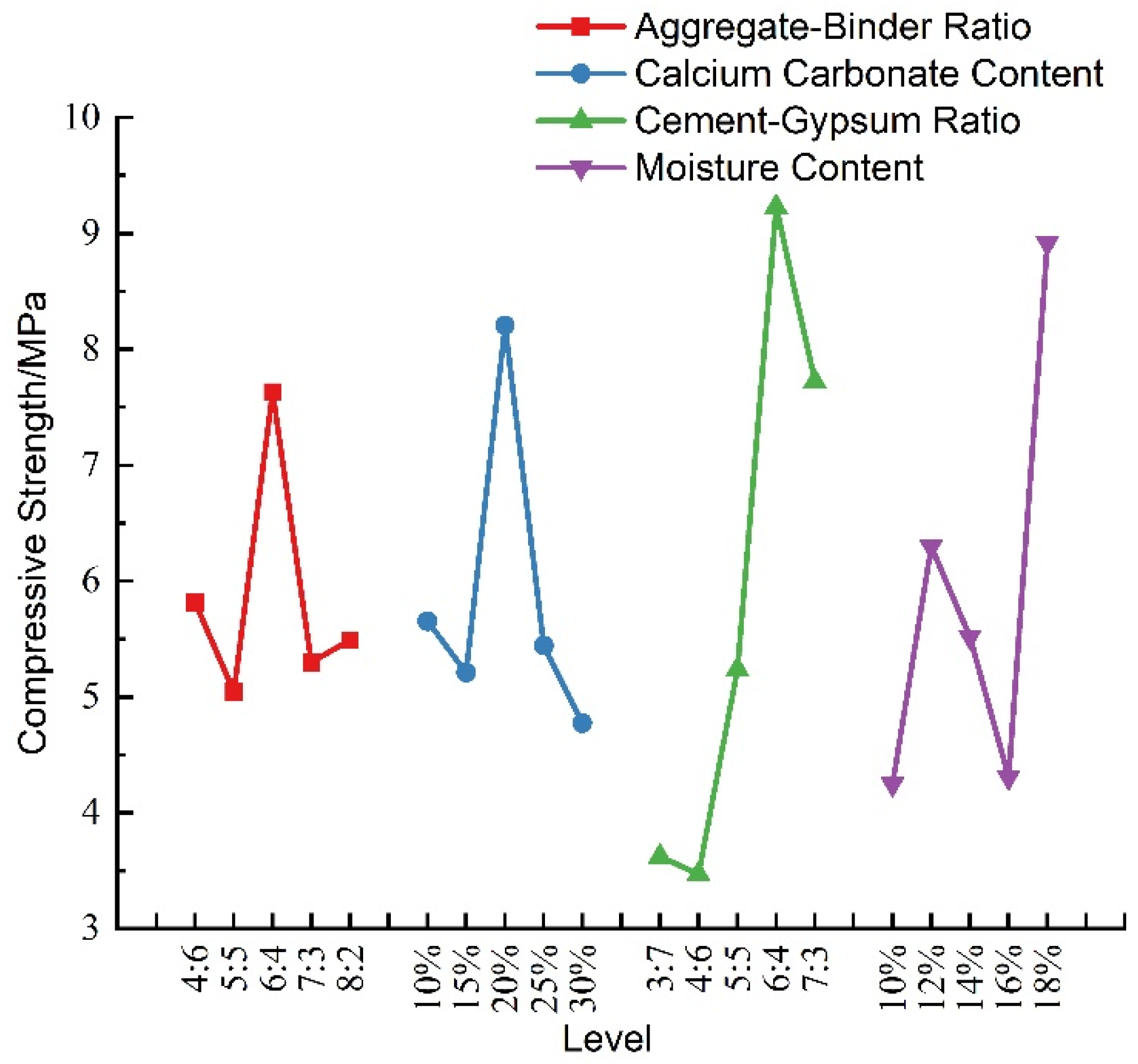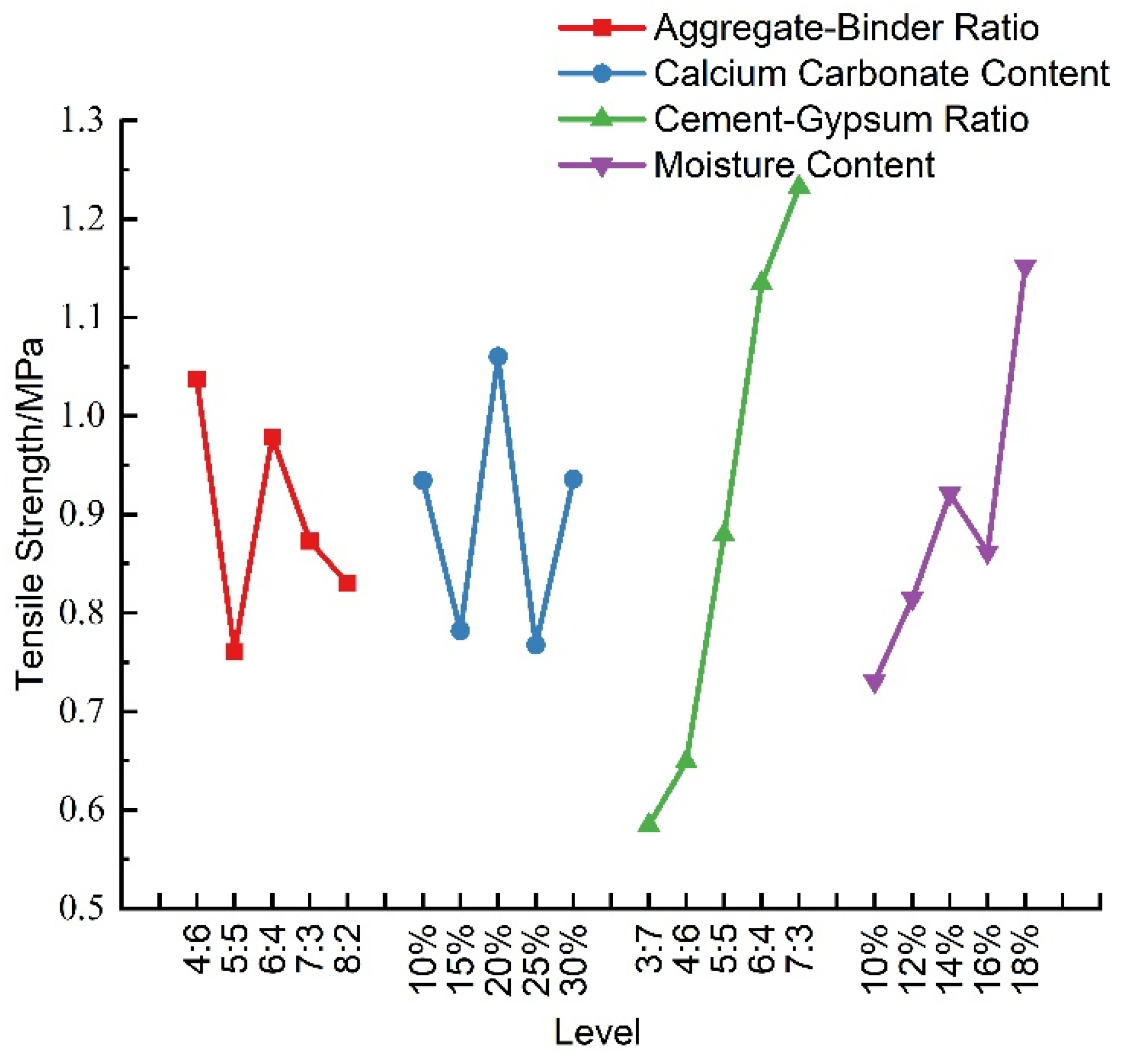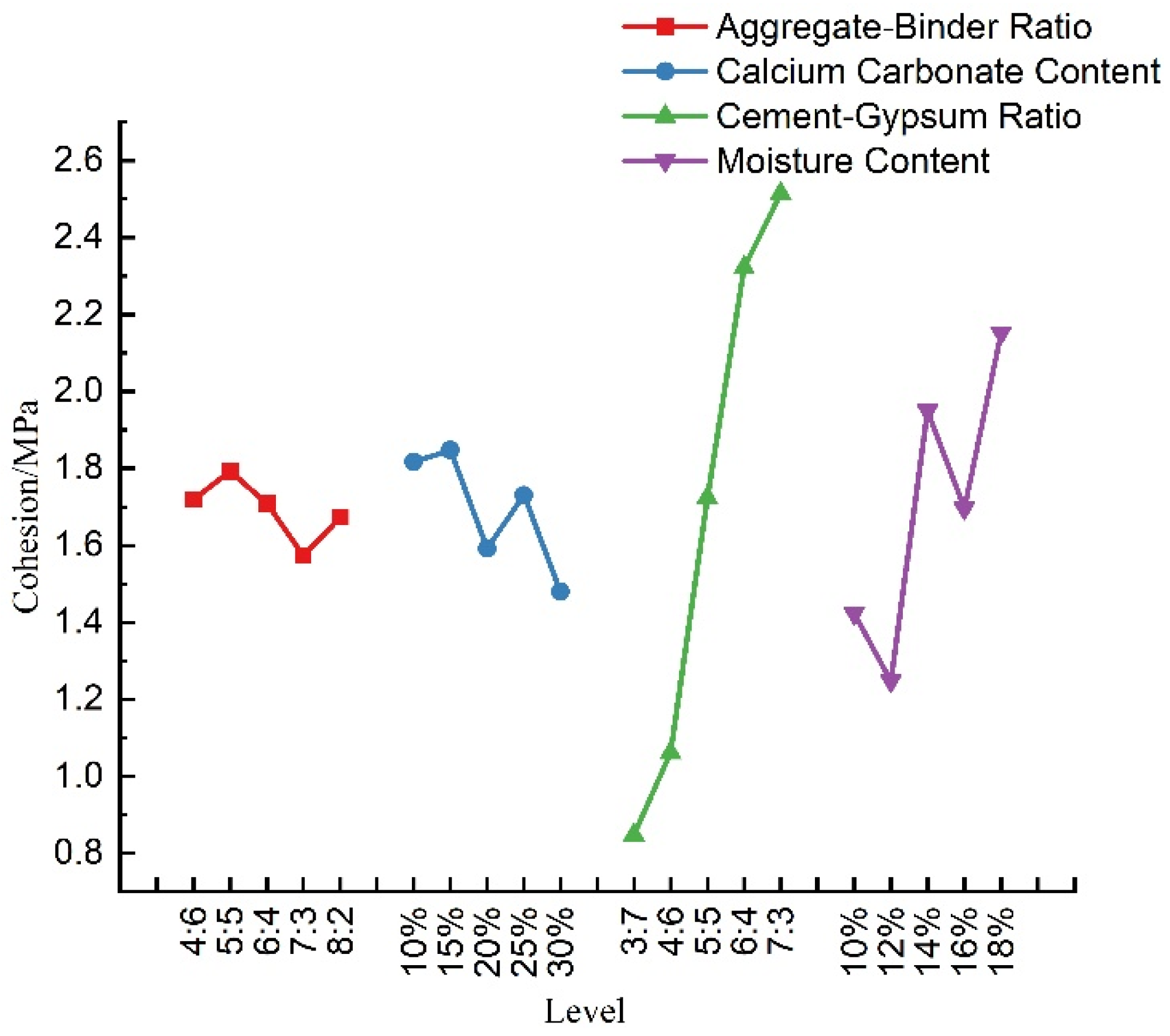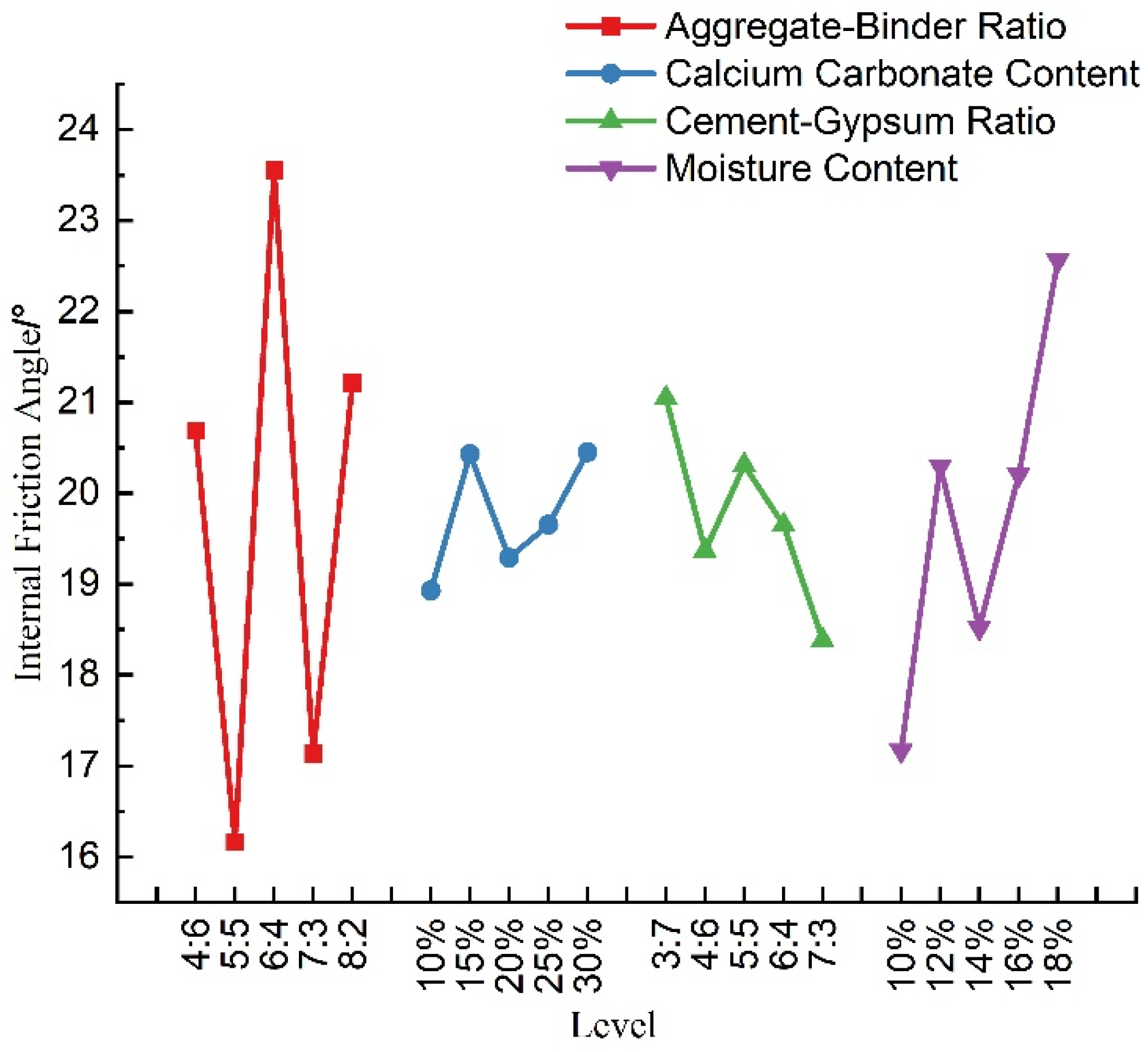Study on Proportioning Scheme of Coal System Rocky Similar Material Based on Orthogonal Test
Abstract
:1. Introduction
2. Similar Material Proportioning Program Design
2.1. Selection of Raw Materials for Similar Materials
- (1)
- A wide range of variation in mechanical parameters of similar materials allows the simulation of different types of rock materials;
- (2)
- The material does not rust and has high insulating properties;
- (3)
- Inexpensive and readily available materials that can significantly reduce test costs;
- (4)
- The material is non-toxic and does not cause any harm to the human body;
- (5)
- Simple production process, easy molding, and short production period;
- (6)
- Stable physical and mechanical properties of the material, less affected by external influences;
- (7)
2.2. Orthogonal Design Scheme
2.2.1. Factors and Level Setting
2.2.2. Orthogonal Design of Proportioning Scheme
3. Sample Production and Testing Procedure
3.1. Sample Production
3.1.1. Preliminary Preparation
3.1.2. Sample Production Process
- (1)
- Mold preparation: After cleaning the molds thoroughly, ensure that the surface moisture is wiped away (in the case of cylindrical molds, disassemble them for cleaning and reassemble after washing). Use a soft-bristle brush to evenly apply a layer of petroleum jelly to the inner walls of the molds. While applying, pay attention to potential omissions at the mold’s corners;
- (2)
- Material preparation: According to the ratios provided in Table 2, calculate the quantities of yellow sand, calcium carbonate, cement, gypsum, and mixing water required for each group’s formulation. Weigh out the specified amounts and set them aside for later use;
- (3)
- Material mixing: Due to the relatively small quantities of raw materials for each formulation, manual mixing is employed. To minimize errors in moisture content caused by water absorption from the ground, choose a non-absorbent surface for mixing whenever possible. After combining the materials mentioned in step (2), conduct a dry mix. Once the materials are uniformly mixed, add the mixing water all at once and continue stirring until a uniform mixture is achieved;
- (4)
- Production of samples: Fill the mold with the mixed materials while compacting manually to prevent layering and ensure uniform filling. During this process, consider two aspects: ① For specimens of the same size, they should be produced by the same individual to minimize errors resulting from differences in compaction force. ② During the compaction process, pay attention to the condition of the seam on cylindrical molds. If excessive force causes the mold to bulge and deform, it is necessary to remake the specimen;
- (5)
- Specimen smoothing. The surface of the specimen is smoothed with a geotechnical knife to keep the dimensions within the tolerance allowed;
- (6)
- Specimen maintenance. In a conservation environment with room-temperature conditions, cover the surface of freshly prepared specimens with plastic wrap to minimize moisture loss; after two days of resting, remove the cling film and remove the mold (the original plan was to remove the mold after two hours of maintenance; however, in the pre-testing process, we found that the strength of the material in two hours did not meet the requirements and could not be normally demolded); if the specimen is damaged by the demolding process, it needs to be re-produced. Continue to condition the specimen for five days after demoulding for a total conditioning period of seven days;
- (7)
- Specimen numbering. Number each set of specimens from 1 to 25 in accordance with the proportion of specimens.
3.2. The Testing Process
4. Test Results
4.1. Overall Analysis of Test Results
4.2. Rock Types That Can Be Modeled by Similar Materials
5. Sensitivity Analysis of Factors
5.1. Range Analysis
5.1.1. Analyses of Density Sensitivity
5.1.2. Sensitivity Analysis of Uniaxial Compressive Strength
5.1.3. Sensitivity Analysis of Tensile Strength
5.1.4. Sensitivity Analysis of Cohesive Strength
5.1.5. Sensitivity Analysis of Internal Friction Angle
5.2. Analysis of Variance (ANOVA)
6. Conclusions
Author Contributions
Funding
Institutional Review Board Statement
Informed Consent Statement
Data Availability Statement
Conflicts of Interest
References
- Chen, S.J.; Wang, H.L.; Zhang, J.; Zhang, J.W.; Xing, H.L.; Wang, H.Y. Experimental Study on Low-Strength Similar-Material Proportioning and Properties for Coal Mining. Adv. Mater. Sci. Eng. 2015, 2015, 696501. [Google Scholar] [CrossRef]
- Li, S.C.; Wang, Q.; Wang, H.T.; Jiang, B.; Wang, D.C.; Li, Y.; Ruan, G.Q. Model test study on surrounding rock deformation and failuremechanisms of deep roadways with thick top coal. Tunn. Undergr. Space Technol. 2015, 47, 52–63. [Google Scholar] [CrossRef]
- Zhang, J.W.; Wang, Z.W.; Song, Z.X. Numerical study on movement of dynamic strata in combined open-pit and underground mining based on similar material simulation experiment. Arab. J. Geosci. 2020, 13, 785. [Google Scholar] [CrossRef]
- Miao, X.X.; Cui, X.M.; Wang, J.A.; Xu, J.L. The height of fractured water-conducting zone in undermined rock strata. Eng. Geol. 2011, 120, 32–39. [Google Scholar] [CrossRef]
- Li, G.L.; Kang, H.J.; Pan, X.H.; Li, S.Q. A Study on Soil Similar Material of Large- Scale Physical Model Test of Deep Pit. Highway 2011, 10, 184–188. Available online: https://kns.cnki.net/kcms2/article/abstract?v=xzY5Ip_ThcnJaGeGF7x4ZupNkobiQMMxvx-oYtl_DCFa4U0aERrBzhRCdaBCF57kdyHBT2JGfaAZxuL04CeZKWuDgzy6yTV5ohMv2UXCAWZvyhhuGimRTd94fgUYth4ymBDIVe_t00U=&uniplatform=NZKPT&language=CHS (accessed on 8 April 2023).
- Yang, S.T.; Chen, N.; Chen, F.Y.; Liu, G.Y.; Zhou, B. Research on similar materials used in model test for deep foundation pit. Railw. Eng. 2015, 9, 78–81. [Google Scholar] [CrossRef]
- Zhan, Z.F.; He, J.X.; Zheng, B.W.; Qi, W.S. Experimental study on similar material proportion of slope model. Prog. Geophys. 2019, 34, 1236–1243. [Google Scholar] [CrossRef]
- Liu, X.L.; Wang, S.M.; Tan, Y.Z.; Hu, X.J.; Zhao, D.P. The Study on the Ratio of Similar Material in Landslide Model Test. Adv. Mater. Res. 2011, 261–263, 1679–1684. [Google Scholar] [CrossRef]
- Li, S.C.; Wang, H.P.; Zhang, Q.Y.; Li, Y. New type geo-mechanical similar material experiments research and its application. Key Eng. Mater. 2006, 326–328, 1801–1804. [Google Scholar] [CrossRef]
- Kong, C.; Guo, X.Q.; Ren, S.B.; Gu, S.; Gu, Y. Physical model test of tunnel complex surrounding rock progressive failure based on strength-reduction similar materials. Eng. Fail. Anal. 2023, 149, 107255. [Google Scholar] [CrossRef]
- Yuan, Z.P.; Chen, X.M.; Yuan, Y.; Zhang, P. Study on ratio of similar material of geomechanical model based on orthogonal test. J. Disaster Prev. Mitig. Eng. 2014, 34, 197–202. [Google Scholar] [CrossRef]
- Zhang, J.; Zuo, S.Y.; Zhang, Y.Z.; He, X.; Wang, L. Study on orthogonal experiment of proportion of rock similar materia. Water Resour. Hydropower Eng. 2019, 50, 161–168. [Google Scholar] [CrossRef]
- Han, B.L.; Li, W.C.; Yang, C.F. A New Model Material of Geomechanics (MIB). Eng. J. Wuhan Univ. 1983, 1, 11–17. Available online: https://kns.cnki.net/kcms2/article/abstract?v=3uoqIhG8C44YLTlOAiTRKth5mPLKqXjbyzE23kHsboMSVy6YgGGhUpAauFf7ojdMe0ct2tEhPs-V1PnE4JqxKd0XgOMevinX&uniplatform=NZKPT (accessed on 8 April 2023).
- Han, B.L.; Cheng, X.L.; Song, Y.L.; Li, H.M. Research on Similar Material of Rockmass. Eng. J. Wuhan Univ. 1997, 30, 7–10. Available online: https://kns.cnki.net/kcms2/article/abstract?v=3uoqIhG8C44YLTlOAiTRKjkpgKvIT9NkZNmQNo4kSVoyzYYayM4cYVIL_d_tg5diEw5RaZkCu3Efc8414WL0Zwvp0E053UcQ&uniplatform=NZKPT (accessed on 8 April 2023).
- Ma, F.P.; Li, Z.K.; Luo, G.F. NIOS model material and its use in geo-mechanical similarity model test. J. Hydroelectr. Eng. 2004, 23, 48–51. Available online: https://kns.cnki.net/kcms2/article/abstract?v=3uoqIhG8C44YLTlOAiTRKgchrJ08w1e7eeyE9jLkqq9sMj44rbGv8W_7UOEUGB0Q810HYoUJ7A58Yci4CLNE305ZsGcu5DTu&uniplatform=NZKPT (accessed on 8 April 2023).
- Wang, H.P.; Li, S.C.; Zhang, Q.Y.; Li, Y.; Guo, X.H. Development of a new geomechanical similar material. Chin. J. Rock Mech. Eng. 2006, 9, 1842–1847. Available online: https://kns.cnki.net/kcms2/article/abstract?v=3uoqIhG8C44YLTlOAiTRKgchrJ08w1e7eWoVfj7plMylkNOGE9nmwKJEN642WqCye3HlKSAZICcXUINWW3jJINR-v4dzNUMS&uniplatform=NZKPT (accessed on 8 April 2023).
- Li, S.C.; Zhou, Y.; Li, L.P.; Zhang, Q.; Song, S.G.; Li, J.L.; Wang, K.; Wang, Q.H. Development and application of a new similar material for underground engineering fluid-solid coupling model test. Chin. J. Rock Mech. Eng. 2012, 31, 1128–1137. Available online: https://kns.cnki.net/kcms2/article/abstract?v=3uoqIhG8C44YLTlOAiTRKgchrJ08w1e7fm4X_1ttJAldfZhFPnrMqPuJ7orCuIcUxUtmSDESw0RA4Aezna3Kj0QDwxXaVoIC&uniplatform=NZKPT (accessed on 8 April 2023).
- Fu, H.Y.; Qi, S.X.; Shi, Z.N.; Zeng, L. Mixing Ratios and Cementing Mechanism of Similar Silty Mudstone Materials for Model Tests. Adv. Civ. Eng. 2021, 2021, 2426130. [Google Scholar] [CrossRef]
- Zhao, W.S.; Guo, H.; Chen, W.Z.; Liu, J.G.; Peng, W.B.; Zhou, S. Experimental study on similar materials for tunnel lining concrete in geomechanical model tests. Eng. Fail. Anal. 2023, 152, 107456. [Google Scholar] [CrossRef]
- Zuo, B.C.; Cheng, C.X.; Liu, C.H.; Shen, Q.; Xiao, G.F.; Liu, X.W. Research on similar material of slope simulation experiment. Rock Soil Mech. 2004, 11, 1805–1808. [Google Scholar] [CrossRef]
- Zhang, Q.Y.; Liu, D.J.; Jia, C.; Shen, X.; Liu, J.; Duan, K. Development of geomechanical model similitude material for salt rock oil-gas storage medium. Rock Soil Mech. 2009, 30, 3581–3586. [Google Scholar] [CrossRef]
- Wang, Y.Y.; Li, F.; Tai, X.J. Experimental Investigating of Latex Cement as Similar Material Simulating Soft Rock Creep. Adv. Mater. Res. 2012, 535–537, 1940–1943. [Google Scholar] [CrossRef]
- Diao, X.H.; Wang, K.; Fu, P.Y. Study on proportioning of similar material to swelling rock. Appl. Mech. Mater. 2014, 501, 439–443. [Google Scholar] [CrossRef]
- Wen, C.X.; Jia, S.P.; Fu, X.F.; Meng, L.D.; Zhao, Z.Y. Experimental Research and Sensitivity Analysis of Mudstone Similar Materials Based on Orthogonal Design. Adv. Mater. Sci. Eng. 2020, 2020, 2031276. [Google Scholar] [CrossRef]
- Yang, M.Z.; Yang, Y.; Zhao, B. Study on the Proportion of Conglomerate Similar MaterialsBased on the Orthogonal Test. Shock. Vib. 2021, 2021, 6657323. [Google Scholar] [CrossRef]
- Li, B.F.; Ren, Y.K.; Qi, W.L.; Chang, L. Study on Orthogonal Mixing Rate Experiment with Low StrengthSimilar Material of Coal and Rock Mass. Coal Eng. 2011, 4, 93–95. Available online: https://kns.cnki.net/kcms2/article/abstract?v=3uoqIhG8C44YLTlOAiTRKgchrJ08w1e7tvjWANqNvp_ybmBcAwrw4mNnFTNmN4C0N0B_ub1XSfMCgyG8s4dYUPs94F4S9T9F&uniplatform=NZKPT (accessed on 8 April 2023).
- Wang, B. The Experimental Design and Research of Coaly Similar Materials Based on Uniform Design Method. Adv. Mater. Res. 2014, 850–851, 233–236. [Google Scholar] [CrossRef]
- Yang, X.Y.; Guo, B.H.; Li, Z.X. Experimental research on similar material proportion based on orthogonaldesign for physical simulation. Coal Mine Mod. 2014, 4, 62–65. [Google Scholar] [CrossRef]
- Dai, L.C. Research on Simulation Test of Coal Similar Material. Adv. Mater. Res. 2014, 2014, 847–850. [Google Scholar] [CrossRef]
- Liu, J.L.; Wang, M.J.; Zhang, D. Study on Similar Model of High Pressure Water Jet Impacting Coal Rock. AIP Conf. Proc. 2017, 1864, 020181. [Google Scholar] [CrossRef]
- Zhou, H.; Cheng, J.; Zhang, C.Q.; Zhu, Y.; Lu, J.J.; Jiang, Y. Experimental study of the rockburst model material with low-strength and high-brittleness. Rock Soil Mech. 2019, 40, 2039–2049. [Google Scholar] [CrossRef]
- Wang, Q.Z.; Ye, H.W.; Li, N.; Ren, G.F.; Lei, T.; Chen, F.D.; Chen, W. Proportioning experiment and strength variation law of similar simulation materials for soft rock of coal measures. Exp. Technol. Manag. 2021, 9, 77–82. [Google Scholar] [CrossRef]
- GB/T 50266-2013; General Administration of Quality Supervision, Inspection and Quarantine of the People’s Republic of China. China Electricity Council, Ministry of Housing and Urban-Rural, Development of the People’s Republic of China: Beijing, China, 2013.
- Chu, Z.F.; Liu, B.G.; Ren, D.R.; Song, Y.; Ma, Q. Development of rheology similar material of soft rock and its application in model test. Rock Soil Mech. 2019, 40, 2172–2182. [Google Scholar] [CrossRef]
- Ren, S.; Guo, S.T.; Jiang, D.Y.; Yang, C.H. Study of creep similar model and creep equivalent material of salt rock. Rock Soil Mech. 2021, 32, 106–110. [Google Scholar] [CrossRef]
- Gan, X.N. Experimental Study on Mechanical Properties of Paraffin, Sand and Plasteras Soft Rock Similar Materials. Master’s Thesis, Qingdao University of Science & Technology, Qingdao, China, 2017. [Google Scholar]
- Cui, N.K.; Wang, J.X.; Cheng, S.L.; Ge, W.M.; Kou, H.J. Experimental study on mix proportion of similar materials of marl. J. Highw. Transp. Res. Dev. 2020, 37, 81–88. [Google Scholar] [CrossRef]
- Liu, Y.R.; Tang, H.M. Rock Mechanics; Chemical Industry Press: Beijing, China, 2008. [Google Scholar]
- Li, Y.Y.; Hu, C.R. Experiment Design and Data Processing; Chemical Industry Press: Beijing, China, 2017. [Google Scholar]
- Dou, Y.M.; Wang, J.N.; Tian, G.Z.; Wei, M. Orthogonal test study on theratio of soft soil similar materials. J. Chongqing Jiaotong Univ. Nat. Sci. 2018, 37, 65–71. [Google Scholar] [CrossRef]









| Levels | Aggregate–Binder Ratio | Calcium Carbonate Content | Cement–Gypsum Ratio | Moisture Content |
|---|---|---|---|---|
| 1 | 4:6 | 10% | 3:7 | 10% |
| 2 | 5:5 | 15% | 4:6 | 12% |
| 3 | 6:4 | 20% | 5:5 | 14% |
| 4 | 7:3 | 25% | 6:4 | 16% |
| 5 | 8:2 | 30% | 7:3 | 18% |
| Number | A (Aggregate–Binder Ratio) | B (Calcium Carbonate Content) | C (Cement–Gypsum Ratio) | D (Moisture Content) | E | F |
|---|---|---|---|---|---|---|
| 1 | 4:6 | 10% | 4:6 | 14% | 4 | 2 |
| 2 | 4:6 | 15% | 6:4 | 10% | 3 | 3 |
| 3 | 4:6 | 20% | 3:7 | 16% | 2 | 4 |
| 4 | 4:6 | 25% | 5:5 | 12% | 1 | 5 |
| 5 | 4:6 | 30% | 7:3 | 18% | 5 | 1 |
| 6 | 5:5 | 10% | 3:7 | 10% | 1 | 1 |
| 7 | 5:5 | 15% | 5:5 | 16% | 5 | 2 |
| 8 | 5:5 | 20% | 7:3 | 12% | 4 | 3 |
| 9 | 5:5 | 25% | 4:6 | 18% | 3 | 4 |
| 10 | 5:5 | 30% | 6:4 | 14% | 2 | 5 |
| 11 | 6:4 | 10% | 7:3 | 16% | 3 | 5 |
| 12 | 6:4 | 15% | 4:6 | 12% | 2 | 1 |
| 13 | 6:4 | 20% | 6:4 | 18% | 1 | 2 |
| 14 | 6:4 | 25% | 3:7 | 14% | 5 | 3 |
| 15 | 6:4 | 30% | 5:5 | 10% | 4 | 4 |
| 16 | 7:3 | 10% | 6:4 | 12% | 5 | 4 |
| 17 | 7:3 | 15% | 3:7 | 18% | 4 | 5 |
| 18 | 7:3 | 20% | 5:5 | 14% | 3 | 1 |
| 19 | 7:3 | 25% | 7:3 | 10% | 2 | 2 |
| 20 | 7:3 | 30% | 4:6 | 16% | 1 | 3 |
| 21 | 8:2 | 10% | 5:5 | 18% | 2 | 3 |
| 22 | 8:2 | 15% | 7:3 | 14% | 1 | 4 |
| 23 | 8:2 | 20% | 4:6 | 10% | 5 | 5 |
| 24 | 8:2 | 25% | 6:4 | 16% | 4 | 1 |
| 25 | 8:2 | 30% | 3:7 | 12% | 3 | 2 |
| Number | Density/(g/cm3) | Uniaxial Compressive Strength/MPa | Tensile Strength/MPa | Cohesion C/MPa | Internal Friction Angle φ/° |
|---|---|---|---|---|---|
| 1 | 1.75 | 3.21 | 0.82 | 1.85 | 10.33 |
| 2 | 1.77 | 5.11 | 0.83 | 1.76 | 17.95 |
| 3 | 1.76 | 3.97 | 0.83 | 0.85 | 23.21 |
| 4 | 1.76 | 6.38 | 0.81 | 1.65 | 24.11 |
| 5 | 1.93 | 10.42 | 1.89 | 2.48 | 27.84 |
| 6 | 1.63 | 2.63 | 0.36 | 1.07 | 12.20 |
| 7 | 1.82 | 2.76 | 0.85 | 2.16 | 17.03 |
| 8 | 1.84 | 9.13 | 0.92 | 1.54 | 13.63 |
| 9 | 1.71 | 4.90 | 0.60 | 1.89 | 15.67 |
| 10 | 1.87 | 5.82 | 1.07 | 2.30 | 22.30 |
| 11 | 1.94 | 6.58 | 1.31 | 2.66 | 24.53 |
| 12 | 1.71 | 4.34 | 0.58 | 0.58 | 26.89 |
| 13 | 2.01 | 17.81 | 1.71 | 3.45 | 18.11 |
| 14 | 1.82 | 4.28 | 0.59 | 0.39 | 31.44 |
| 15 | 1.81 | 5.16 | 0.70 | 1.43 | 18.89 |
| 16 | 1.96 | 9.95 | 1.22 | 1.85 | 20.51 |
| 17 | 1.85 | 5.56 | 0.60 | 1.28 | 24.11 |
| 18 | 1.98 | 6.01 | 1.08 | 1.72 | 14.44 |
| 19 | 1.86 | 4.20 | 0.99 | 2.44 | 9.74 |
| 20 | 1.76 | 0.78 | 0.48 | 0.57 | 16.87 |
| 21 | 1.99 | 5.90 | 0.95 | 1.65 | 27.08 |
| 22 | 1.98 | 8.28 | 1.04 | 3.45 | 16.18 |
| 23 | 1.96 | 4.13 | 0.77 | 0.41 | 27.08 |
| 24 | 1.95 | 7.45 | 0.84 | 2.24 | 19.39 |
| 25 | 1.94 | 1.69 | 0.54 | 0.61 | 16.36 |
| Rock Type | Density/ (g/cm3) | Uniaxial Compressive Strength/MPa | Cohesion/MPa | Internal Friction Angle/(°) |
|---|---|---|---|---|
| Main Coking Coal | 1.2–1.7 | 4.9–49 | 0.98–9.81 | 16–40 |
| Anthracite | 1.2–1.7 | 9.81–15.7 | 1.96–3.92 | 28–35 |
| Chimneystone, Schist | 2.5–3.3 | 10–100 | 1–20 | 26–65 |
| Shale | 2.1–2.8 | 4.5–78.5 | 6.63–20 | 11–60 |
| Marl | 2.3–2.5 | 3.5–20 | 200–700 | 9–65 |
| Similar materials | 1.63–2.01 | 0.78–17.81 | 0.39–3.45 | 9.74–31.44 |
| Level Average | Aggregate–Binder Ratio | Calcium Carbonate Content/% | Cement–Gypsum Ratio | Moisture Content/% |
|---|---|---|---|---|
| k1 | 1.79 | 1.85 | 1.78 | 1.88 |
| k2 | 1.77 | 1.83 | 1.91 | 1.81 |
| k3 | 1.86 | 1.91 | 1.80 | 1.85 |
| k4 | 1.88 | 1.82 | 1.87 | 1.84 |
| k5 | 1.96 | 1.86 | 1.91 | 1.90 |
| Range | 0.19 | 0.09 | 0.14 | 0.09 |
| Level Average | Aggregate–Binder Ratio | Calcium Carbonate Content/% | Cement–Gypsum Ratio | Moisture Content/% |
|---|---|---|---|---|
| k1 | 5.82 | 5.65 | 3.47 | 5.52 |
| k2 | 5.05 | 5.21 | 9.23 | 4.25 |
| k3 | 7.63 | 8.21 | 3.62 | 4.31 |
| k4 | 5.30 | 5.44 | 5.24 | 6.30 |
| k5 | 5.49 | 4.77 | 7.72 | 8.92 |
| Range | 2.59 | 3.43 | 5.76 | 4.67 |
| Level Average | Aggregate–Binder Ratio | Calcium Carbonate Content/% | Cement–Gypsum Ratio | Moisture Content/% |
|---|---|---|---|---|
| k1 | 1.04 | 0.93 | 0.65 | 0.92 |
| k2 | 0.76 | 0.78 | 1.13 | 0.73 |
| k3 | 0.98 | 1.06 | 0.58 | 0.86 |
| k4 | 0.87 | 0.77 | 0.88 | 0.81 |
| k5 | 0.83 | 0.94 | 1.23 | 1.15 |
| Range | 0.28 | 0.29 | 0.65 | 0.42 |
| Level Average | Aggregate–Binder Ratio | Calcium Carbonate Content/% | Cement–Gypsum Ratio | Moisture Content/% |
|---|---|---|---|---|
| k1 | 1.72 | 1.82 | 1.06 | 1.94 |
| k2 | 1.79 | 1.85 | 2.32 | 1.42 |
| k3 | 1.70 | 1.59 | 0.84 | 1.70 |
| k4 | 1.57 | 1.72 | 1.72 | 1.25 |
| k5 | 1.67 | 1.48 | 2.51 | 2.15 |
| Range | 0.22 | 0.37 | 1.67 | 0.90 |
| Level Average | Aggregate–Binder Ratio | Calcium Carbonate Content/% | Cement–Gypsum Ratio | Moisture Content/% |
|---|---|---|---|---|
| k1 | 20.69 | 18.93 | 19.37 | 18.94 |
| k2 | 16.16 | 20.43 | 19.65 | 17.17 |
| k3 | 23.97 | 19.29 | 21.46 | 20.21 |
| k4 | 17.14 | 20.07 | 20.31 | 20.30 |
| k5 | 21.22 | 20.45 | 18.39 | 22.56 |
| Range | 7.81 | 1.52 | 3.08 | 5.39 |
| Factor | Aggregate–Binder Ratio | Calcium Carbonate Content/% | Cement–Gypsum Ratio | Moisture Content/% | Error |
|---|---|---|---|---|---|
| Density | SSA:0.115 | SSB:0.027 | SSC:0.081 | SSD:0.025 | SSe:0.025 |
| dfA:4 | dfB:4 | dfC:4 | dfD:4 | dfe:8 | |
| MSA:0.029 | MSB:0.007 | MSC:0.02 | MSD:0.006 | MSe:0.003 | |
| FA:9.406 | FB:2.202 | FC:6.619 | FD:2.054 | ||
| PA:0.004 | PB:0.159 | PC:0.012 | PD:0.179 | ||
| ** | — | * | — | ||
| Compressive | SSA:21.275 | SSB:36.654 | SSC:129.529 | SSD:73.324 | SSe:25.87 |
| dfA:4 | dfB:4 | dfC:4 | dfD:4 | dfe:8 | |
| MSA:5.319 | MSB:9.163 | MSC:32.382 | MSD:18.331 | MSe:3.234 | |
| FA:1.645 | FB:2.834 | FC:10.014 | FD:5.669 | ||
| PA:0.254 | PB:0.098 | PC:0.003 | PD:0.018 | ||
| — | — | ** | * | ||
| Tensile Strength | SSA:0.249 | SSB:0.298 | SSC:1.64 | SSD:0.505 | SSe:0.377 |
| dfA:4 | dfB:4 | dfC:4 | dfD:4 | dfe:8 | |
| MSA:0.062 | MSB:0.074 | MSC:0.41 | MSD:0.126 | MSe:0.047 | |
| FA:1.319 | FB:1.579 | FC:8.703 | FD:2.681 | ||
| PA:0.341 | PB:0.27 | PC:0.005 | PD:0.11 | ||
| — | — | ** | — | ||
| Cohesion | SSA:0.127 | SSB:0.48 | SSC:10.972 | SSD:2.723 | SSe:3.285 |
| dfA:4 | dfB:4 | dfC:4 | dfD:4 | dfe:8 | |
| MSA:0.032 | MSB:0.12 | MSC:2.743 | MSD:0.681 | MSe:0.411 | |
| FA:0.076 | FB:0.288 | FC:6.585 | FD:1.634 | ||
| PA:0.987 | PB:0.878 | PC:0.012 | PD:0.249 | ||
| — | — | * | — | ||
| Internal Friction | SSA:202.604 | SSB:9.546 | SSC:26.171 | SSD:78.474 | SSe:498.663 |
| dfA:4 | dfB:4 | dfC:4 | dfD:4 | dfe:8 | |
| MSA:50.651 | MSB:2.387 | MSC:6.543 | MSD:19.618 | MSe:62.333 | |
| FA:0.818 | FB:0.038 | FC:0.105 | FD:0.315 | ||
| PA:0.551 | PB:0.997 | PC:0.978 | PD:0.86 | ||
| — | — | — | — |
Disclaimer/Publisher’s Note: The statements, opinions and data contained in all publications are solely those of the individual author(s) and contributor(s) and not of MDPI and/or the editor(s). MDPI and/or the editor(s) disclaim responsibility for any injury to people or property resulting from any ideas, methods, instructions or products referred to in the content. |
© 2023 by the authors. Licensee MDPI, Basel, Switzerland. This article is an open access article distributed under the terms and conditions of the Creative Commons Attribution (CC BY) license (https://creativecommons.org/licenses/by/4.0/).
Share and Cite
Sun, L.; Wang, W.-X.; Xu, J.-S. Study on Proportioning Scheme of Coal System Rocky Similar Material Based on Orthogonal Test. Materials 2023, 16, 7113. https://doi.org/10.3390/ma16227113
Sun L, Wang W-X, Xu J-S. Study on Proportioning Scheme of Coal System Rocky Similar Material Based on Orthogonal Test. Materials. 2023; 16(22):7113. https://doi.org/10.3390/ma16227113
Chicago/Turabian StyleSun, Lin, Wan-Xu Wang, and Ji-Shan Xu. 2023. "Study on Proportioning Scheme of Coal System Rocky Similar Material Based on Orthogonal Test" Materials 16, no. 22: 7113. https://doi.org/10.3390/ma16227113





